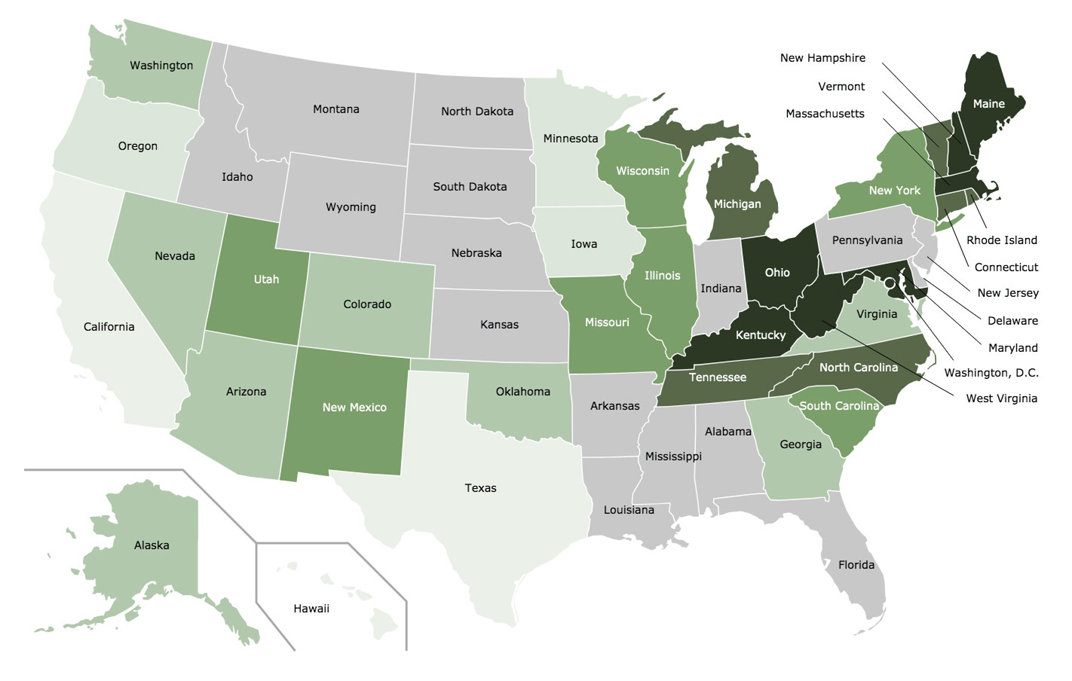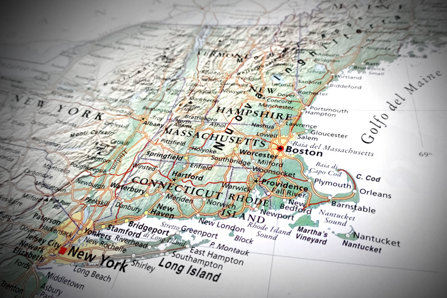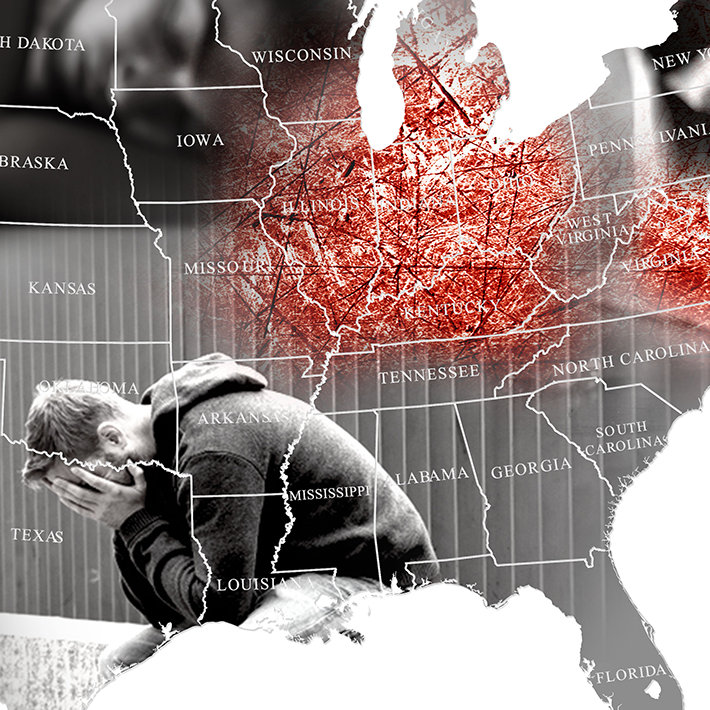The Regions with the Least Significant and Most Significant Drug Problems—A Comparison

When we look at the news and general media discourse regarding drug and alcohol addiction, the subject matter is not that encouraging. It is easy enough to find headlines on “The Top Five States Most Affected by Drug Addiction,” or “The Three States with the Worst Drug Overdose Problems,” or “These Ten Cities Have the Most Drug Use in the Country,” and so on. Those are the headlines that draw the most attention, the subject matter that news-savvy individuals find the most exciting and eye-catching.
But what if we could take a minute and focus instead on the regions which are having some success in curbing their drug problems? What if we could take a minute and instead talk about some of the cities, states, or regions which have lower than average drug use rates, overdose deaths, drug crime, etc.?
At the very least, it would be interesting to learn which areas these are. At most, we might be able to understand the disparity between regions that have few drug issues and the areas which have serious drug issues. We could understand better why drug problems are a bigger problem in some areas compared to others.
East versus West—Looking at the Opioid Overdose Rates
Most people understand at this point that the opioid crisis is one of the worst, if not the worst drug problem in the United States right now. It is undoubtedly the most lethal drug problem at this time.
The National Institute on Drug Abuse has a map which breaks down, geographically, the opioid overdose death rate in each state and region in the U.S. According to the map and its accompanying data, the West Coast and the western states in the Midwest tended to fair pretty well for avoiding overdose deaths. The map shows that opioid overdose deaths are not shared equally across the United States. By far, the Northeast, eastern Midwest, and the Southeast are hit the hardest by opioid overdoses.

What made for this stark difference in overdoses, East Coast to West Coast? While we can’t nail down one deciding factor precisely, it is likely that the sheer disparity in pharmaceutical distribution in the late-1990s and early to mid-2000s played a significant role. This is to say that, when pharmaceutical companies began to push their opioid drugs heavily on doctors and consumers, these companies were sending their drugs to mining communities in Appalachia, the poor South, the depressed, economically downtrodden manufacturing towns of the Midwest, the densely populated cities of the East Coast, the rural Northeast, and so on.
Big Pharma companies worked with local doctors and pharmacies in these areas to create a massive proliferation of highly addictive prescription drugs. Pharmaceutical companies simply did not distribute opioid pain relievers to the west side of the nation as much as they did to the east side.
Opioid Prescribing—Key Insights to Where in the U.S. Opioids Are Pushed
Following from the previous section, let’s look at another example that shows two ends of the spectrum. Let’s examine the regions with the most opioid prescribing per capita, and let’s also look at the areas with the least opioid prescribing per capita.
I think we can all agree that no matter where you go in the United States, the degrees and levels of physical pain felt by locals will be about the same. Pain statistics should be about the same in every U.S. state. It would be more than a little silly to theorize that some states struggle with significantly higher pain problems than others do. Therefore, in a perfect world, every state would receive about the same degree of pain treatments and pain relievers.
So why is it that some states receive several times more painkiller shipments and prescriptions for painkillers than others do? Again, we have a concerning disparity in the opioid sector—a discrepancy which has created an addiction epidemic in some areas while leaving other regions mostly untouched.
An interesting research piece published in Forbes discussed the drug problem in depth, sticking mainly to opioid drugs, and exploring substantial disparities in different regions across the U.S. when it came to various factors of the opioid crisis.
Here is what the article found on opioid prescribing. The states which had the most prescriptions per capita filled out for opioid pain relievers were:
- Alabama
- Arkansas
- Tennessee
- Mississippi
- Louisiana
The regions which had the least prescriptions per capita filled out for opioid pain relievers were:
- Minnesota
- California
- New York
- Hawaii
- Washington D.C.
On average, the five states with the most prescriptions received 400 percent more prescriptions per capita than the regions with the least prescriptions. Is it feasible that the highest-prescribed states had four times the pain problems as the lowest prescribed? Absolutely not. And not so coincidentally, the states with the most opioid prescribing also tended to be the states that posted the most opioid overdoses each year. And while some patients may complain of untreated pain in the states with the lowest opioid prescribing rates, you can bet there are far fewer per capita opioid deaths in those states.
Drug Crime—Another Indicator of a Region’s Drug Problem
Let’s look at another sector by which we can gauge a region’s drug presence: drug-related arrests. When regions have very low drug-related arrests, that usually means that area has done an excellent job at keeping trafficked drugs out of that region.
Conversely, when a region has a high number of drug-related arrests, it can mean that drug policy in that area is such that local law enforcement cracks down more heavily on low-level offenders. It can also mean that the region is on the crossroads of significant trafficking operations. Or it can mean simply that the area is a hotspot for illegal drug use.

The five areas with the most drug arrests are:
- South Dakota
- Wyoming
- Mississippi
- Missouri
- New Jersey
Most of those states lie in the Midwest region, which makes sense. The Midwest is currently a hotspot for opioid misuse, particularly with illegal, street-dealt fentanyl and other synthetic opioids.
The areas with the fewest drug arrests per capita are:
- Vermont
- Washington
- Rhode Island
- Massachusetts
- Alaska
Most of these regions are on the east coast, a place where current efforts to utilize treatment over incarceration are very strong. And Washington state is replicating that model as well, with their LEAD program. That is a good sign. When states move towards treatment over incarceration, a reduction in drug overdose statistics usually follows.
Creating Safe, Drug-Free Environments across the Entire Nation
We can learn quite a bit from studying the nation as a whole and comparing different regions and their drug issues (or lack thereof). Our goal, however, has to be on creating drug-free communities all across the nation.
There are several ways to go about that. For one thing, we have to increase access to addiction treatment for those who need rehab but can’t seem to get it. We also need to reduce pharmaceutical opioid prescribing. Furthermore, we need to shift from a pro-incarceration stance to a pro-rehabilitation position. Regions all across the nation are showing us that the drug problem can be resolved and it can be protected against. Let’s all work together until this epidemic is a thing of the past across the entire nation.
Sources:
- https://www.drugabuse.gov/drugs-abuse/opioids/opioid-summaries-by-state
- https://www.vox.com/science-and-health/2018/1/30/16951316/opioid-epidemic-painkillers-west-virginia-shipments
- https://www.reuters.com/article/us-usa-crime-opioids/dozens-of-doctors-in-appalachia-charged-in-opioid-fraud-bust-idUSKCN1RT2B7
- https://www.forbes.com/sites/nicolefisher/2018/06/01/drug-use-rankings-show-big-surprises-even-bigger-problems/#58d8654e77c2
- https://www.seattletimes.com/seattle-news/crime/lead-program-aimed-at-helping-instead-of-punishing-addicts-to-expand-to-burien/
Reviewed by Claire Pinelli, ICAADC, CCS, LADC, RAS, MCAP


